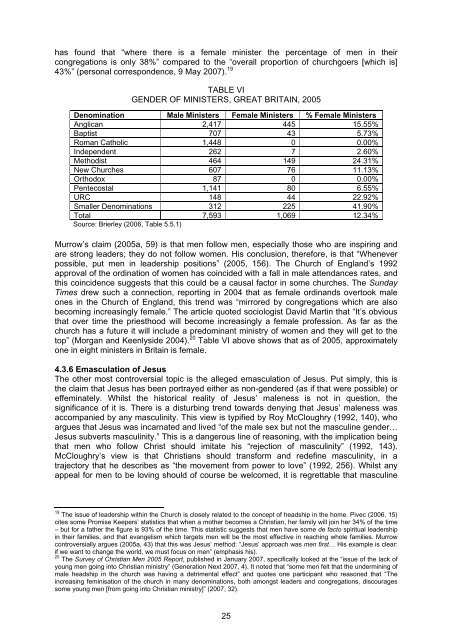Disbanded Brothers – Has a ‘Feminised’ Church Alienated Men in the UK?
Disbanded Brothers - Has a 'Feminised' Church ... - Theduckers.org
Disbanded Brothers - Has a 'Feminised' Church ... - Theduckers.org
- No tags were found...
You also want an ePaper? Increase the reach of your titles
YUMPU automatically turns print PDFs into web optimized ePapers that Google loves.
has found that “where <strong>the</strong>re is a female m<strong>in</strong>ister <strong>the</strong> percentage of men <strong>in</strong> <strong>the</strong>ir<br />
congregations is only 38%” compared to <strong>the</strong> “overall proportion of churchgoers [which is]<br />
43%” (personal correspondence, 9 May 2007). 19<br />
TABLE VI<br />
GENDER OF MINISTERS, GREAT BRITAIN, 2005<br />
Denom<strong>in</strong>ation Male M<strong>in</strong>isters Female M<strong>in</strong>isters % Female M<strong>in</strong>isters<br />
Anglican 2,417 445 15.55%<br />
Baptist 707 43 5.73%<br />
Roman Catholic 1,448 0 0.00%<br />
Independent 262 7 2.60%<br />
Methodist 464 149 24.31%<br />
New <strong>Church</strong>es 607 76 11.13%<br />
Orthodox 87 0 0.00%<br />
Pentecostal 1,141 80 6.55%<br />
URC 148 44 22.92%<br />
Smaller Denom<strong>in</strong>ations 312 225 41.90%<br />
Total 7,593 1,069 12.34%<br />
Source: Brierley (2006, Table 5.5.1)<br />
Murrow’s claim (2005a, 59) is that men follow men, especially those who are <strong>in</strong>spir<strong>in</strong>g and<br />
are strong leaders; <strong>the</strong>y do not follow women. His conclusion, <strong>the</strong>refore, is that “Whenever<br />
possible, put men <strong>in</strong> leadership positions” (2005, 156). The <strong>Church</strong> of England’s 1992<br />
approval of <strong>the</strong> ord<strong>in</strong>ation of women has co<strong>in</strong>cided with a fall <strong>in</strong> male attendances rates, and<br />
this co<strong>in</strong>cidence suggests that this could be a causal factor <strong>in</strong> some churches. The Sunday<br />
Times drew such a connection, report<strong>in</strong>g <strong>in</strong> 2004 that as female ord<strong>in</strong>ands overtook male<br />
ones <strong>in</strong> <strong>the</strong> <strong>Church</strong> of England, this trend was “mirrored by congregations which are also<br />
becom<strong>in</strong>g <strong>in</strong>creas<strong>in</strong>gly female.” The article quoted sociologist David Mart<strong>in</strong> that “It’s obvious<br />
that over time <strong>the</strong> priesthood will become <strong>in</strong>creas<strong>in</strong>gly a female profession. As far as <strong>the</strong><br />
church has a future it will <strong>in</strong>clude a predom<strong>in</strong>ant m<strong>in</strong>istry of women and <strong>the</strong>y will get to <strong>the</strong><br />
top” (Morgan and Keenlyside 2004). 20 Table VI above shows that as of 2005, approximately<br />
one <strong>in</strong> eight m<strong>in</strong>isters <strong>in</strong> Brita<strong>in</strong> is female.<br />
4.3.6 Emasculation of Jesus<br />
The o<strong>the</strong>r most controversial topic is <strong>the</strong> alleged emasculation of Jesus. Put simply, this is<br />
<strong>the</strong> claim that Jesus has been portrayed ei<strong>the</strong>r as non-gendered (as if that were possible) or<br />
effem<strong>in</strong>ately. Whilst <strong>the</strong> historical reality of Jesus’ maleness is not <strong>in</strong> question, <strong>the</strong><br />
significance of it is. There is a disturb<strong>in</strong>g trend towards deny<strong>in</strong>g that Jesus’ maleness was<br />
accompanied by any mascul<strong>in</strong>ity. This view is typified by Roy McCloughry (1992, 140), who<br />
argues that Jesus was <strong>in</strong>carnated and lived “of <strong>the</strong> male sex but not <strong>the</strong> mascul<strong>in</strong>e gender…<br />
Jesus subverts mascul<strong>in</strong>ity.” This is a dangerous l<strong>in</strong>e of reason<strong>in</strong>g, with <strong>the</strong> implication be<strong>in</strong>g<br />
that men who follow Christ should imitate his “rejection of mascul<strong>in</strong>ity” (1992, 143).<br />
McCloughry’s view is that Christians should transform and redef<strong>in</strong>e mascul<strong>in</strong>ity, <strong>in</strong> a<br />
trajectory that he describes as “<strong>the</strong> movement from power to love” (1992, 256). Whilst any<br />
appeal for men to be lov<strong>in</strong>g should of course be welcomed, it is regrettable that mascul<strong>in</strong>e<br />
19 The issue of leadership with<strong>in</strong> <strong>the</strong> <strong>Church</strong> is closely related to <strong>the</strong> concept of headship <strong>in</strong> <strong>the</strong> home. Pivec (2006, 15)<br />
cites some Promise Keepers’ statistics that when a mo<strong>the</strong>r becomes a Christian, her family will jo<strong>in</strong> her 34% of <strong>the</strong> time<br />
<strong>–</strong> but for a fa<strong>the</strong>r <strong>the</strong> figure is 93% of <strong>the</strong> time. This statistic suggests that men have some de facto spiritual leadership<br />
<strong>in</strong> <strong>the</strong>ir families, and that evangelism which targets men will be <strong>the</strong> most effective <strong>in</strong> reach<strong>in</strong>g whole families. Murrow<br />
controversially argues (2005a, 43) that this was Jesus’ method: “Jesus’ approach was men first… His example is clear:<br />
if we want to change <strong>the</strong> world, we must focus on men” (emphasis his).<br />
20 The Survey of Christian <strong>Men</strong> 2005 Report, published <strong>in</strong> January 2007, specifically looked at <strong>the</strong> “issue of <strong>the</strong> lack of<br />
young men go<strong>in</strong>g <strong>in</strong>to Christian m<strong>in</strong>istry” (Generation Next 2007, 4). It noted that “some men felt that <strong>the</strong> underm<strong>in</strong><strong>in</strong>g of<br />
male headship <strong>in</strong> <strong>the</strong> church was hav<strong>in</strong>g a detrimental effect” and quotes one participant who reasoned that “The<br />
<strong>in</strong>creas<strong>in</strong>g fem<strong>in</strong>isation of <strong>the</strong> church <strong>in</strong> many denom<strong>in</strong>ations, both amongst leaders and congregations, discourages<br />
some young men [from go<strong>in</strong>g <strong>in</strong>to Christian m<strong>in</strong>istry]” (2007, 32).<br />
25






